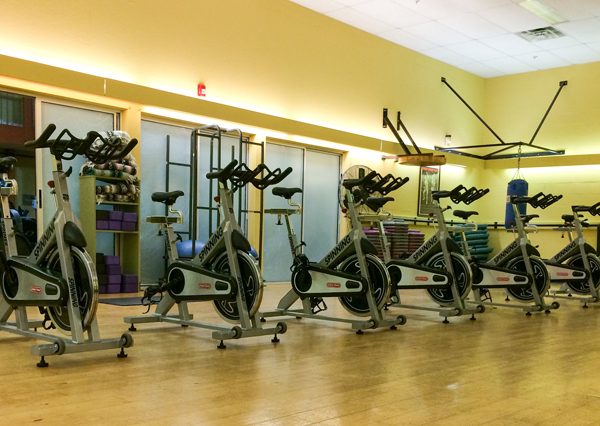 Happy Memorial Day! I hope you all are off doing fun long-weekend things instead of reading this blog post.
Happy Memorial Day! I hope you all are off doing fun long-weekend things instead of reading this blog post.
On Saturday, I drove up to New Hampshire to take a 9-hour Spinning certification workshop. Not how I typically spend Memorial Day weekend (quite the opposite, actually), but I’ve fallen so in love with teaching group fitness that I want to expand my expertise to the stationary bike, and this was the only day that worked for my schedule. I still have to take the online test to be officially certified, and once I do, I’ll put together a post talking more about my experience with it and the details of the certification.
For today, I just wanted to share a little interesting tidbit about the world of stationary bikes and clear up some common misnomers and confusions—there’s actually quite a bit of controversy surrounding “Spinning” vs. “indoor cycling.”
Spinning is a trademarked name, and is what you might think of as the traditional bike class you’d take at the gym (more common a few years ago). It’s based off outdoor cycling, so if you wouldn’t do it riding a bike outdoors, you don’t do it on the stationary bike. The workouts are supposed to replicate situations you might find yourself in on the road or in a race, and are built around heart rate zones—there’s actually a huge emphasis on this and wearing a heart rate monitor is strongly encouraged. Classes are each focused on different training types as well. Monday might be a strength ride, while Tuesday is a recovery ride, Wednesday an endurance ride, and Thursday a race day (you simulate a road race on the stationary bikes, pushing your hardest at the highest gear you can). To be an official “Spinning” studio, all the instructors must be Spinning certified through Mad Dogg Athletics and adhere to the program.
So that fun, trendy class you just took where you’re dancing around on the bike, using hand weights, doing push ups on the handle bars, and riding to the beat of the music? Not a spinning class. That’s an indoor cycling class. Pretty much everything you do in a SoulCycle “indoor cycling” class is prohibited in a Spinning class for safety reasons, or because it’s simply just not something you’d do on an outdoor bike. Unlike Spinning, where one day might be a recovery ride or a class where the goal is to keep your heart rate below 75% of your max, the goal of indoor cycling classes is always to kick your butt and leave you feeling totally spent. Think about it: if you’re spending $20+ per boutique cycling class, you want to feel like you got a killer workout–and people often associate killer workouts with a high heart rate, pouring sweat and a high-intensity class. I’m guilty of this as well–hell no am I spending $25 on a recovery ride. But in the training world…yes, these are just as important as classes where you push at max exertion rates.
To most people, it’s like…who cares. Spinning, indoor cycling—close enough. But the Spinning community is actually pretty up in arms about studios like SoulCycle and FlyWheel being commonly referred to as spin or spinning studios. Some hardcore cyclists and triathletes are flat-out appalled at what people are doing on stationary bikes in today’s group fitness classes because it goes against everything you’d do riding outdoors or racing.
The master trainer who taught my Spinning course on Saturday is a devoted and incredibly knowledgeable cyclist, and I found it fascinating hearing her opinions on these trendy boutique classes—especially since I love them. It’s ironic that I got Spinning certified, because the type of classes I love and want to teach aren’t even technically “Spinning” classes. I’ll get more into it in the post I do about the course, but I’m still so happy I did it—I learned a ton.
Traditional Spinning vs. Indoor Cycling—which do you prefer? And did you know that Spinning and indoor cycling were two different things?









Very interesting! Pursuit (which is way more traditional) is my favorite spinning studio around here–I think I prefer it just a little bit over indoor cycling. I like Flywheel too but need two days to recover after a class there. Not as much of a fan of the ones with the trendy stuff / tons of arms songs / etc.
I’ve been meaning to check out Pursuit–especially now that I’ve taken this course, I’d be interested to see how it differs from other studios.
I love Pursuit! they offer arms and core combo classes that are 30 minutes of spin and 30 minutes off bike weights.
This is a great post. I love spinning and indoor cycling. I kinda knew there was a difference but I wouldn’t have been able to articulate what it was before reading your post. I think my favorite classes are actually a mix of the two. I love Flywheel because there iare enough climbs and sprints to give me a serious spinning vibe but then there’s the arm section which I guess, makes it indoor cycling. I have to be in a certain mood for Soul Cycle and that mood usual revolves around there being an opportunity for a free class because I can’t bring myself to shell out 32 bucks + shoe rental for one class. I would love to work at both of these places. Even though I prefer Flywheel, Soul Cycle just honestly seems like it would be more fun to work at! Looking forward to your post about the actual certification class. Even though I’m in grad school and can’t full out pursue a career in fitness right now, I think it’d be awesome to teach spin classes on the side. I think it would make me really happy!
I am so encouraging of anyone wanting to instruct fitness classes–I have absolutely fallen in love with it since I started back in February! 🙂 And I’m with you–I love SoulCycle, but notttt so much the price. FlyWheel is great, too, but I’m so competitive that I end up staring the the Torq board the entire time and totally forget to just enjoy the class haha.
Very interesting. I’m not really into spinning at all, but it’s good to know the difference. Have you heard of Les Mills RPM? That’s a cycling class that probably falls more into the spinning category, because it does model the road-riding. I’ve taken that program as a member a bunch, but have never had the desire to get certified in anything cycling-wise. Good for you!
I’m more familiar with Les Mills RPM classes too – Les Mills is very popular down here in Australia.
Since I bought my own spin bike, I’ve been focusing more on “virtual cycling”, riding to DVDs filmed by cyclists on the road in different locations. They are a lot of fun, and a great option for people like me who have never ridden a bike IRL – and I’m very unlikely to get hit by a truck!
That kinda reminds me of Peloton Cycle–have you heard of them? It’s this (very expensive) indoor bike that comes with a screen that streams live cycling classes that you can do along at home. Way out of my budget, but a totally cool idea!
I’ve heard of Les Mills, but never taken a class–I’d love to try it though!
I knew it! I’ve got Mad Dogg Athletics certification with of course 6 years experience. I prefer spinning to indoor cycling because of what You said. Spinning is safer for participants. Indoor cycling is too strange for me. I’d rather go to zumba or any kind of dance classes tha to go for indoor cycl. Wneh I want ride a bike, I am ready fot riding. Whet I want take TRX or joga or classes with weights I go for ABT , dance or power pump classes. It seems strange to me what else can fitness instructors create!
It’s true–I’ve seen some strange things (super fun, but strange haha) happen on spin bikes. I LOVE that indoor cycling classes are typically done to the beat of the music, so that’s one thing I will totally keep when I teach, but will eliminate the non-Spinning moves that could be unsafe.
Oh wow, I didn’t know there was a difference! I’ve apparently only taken spinning classes and always wondered why they never included any hand-weights, ha! Guess I should check out an indoor cycling class 🙂
Thanks for explaining the difference! I was actually curious about this before, so this was definitely a helpful read 🙂
Lexi from http://www.prettyandfresh.com/
Great post on the differences between spinning classes and indoor cycling! I’ve been trying to explain the difference to friends who laugh off my spin classes as poofy classes and not worth the time. I didn’t understand their attitude until I started looking around at indoor cycling classes and then it was like OHHHHHH. All the spinning classes I’ve ever been to were intense and satisfying and definitely did not include dancing around on my bike. Great post!
That’s the biggest thing I took away from the course–spinning CAN be just as intense and give you just as good of a workout as indoor cycling. Total eye opener for me! I’ll always love indoor cycling, but now spinning gets the thumbs up, too 🙂
Wow! This post just opened up my MIND!!! I’m a triathlete, and so I have a few thoughts on this. I guess first off, I consider any “indoor cycling” or “spinning” workout to be equivalent. Because any time I’m trying to mimic an outdoor ride, I call it a “trainer” workout. I put my regular bike on a trainer, and “ride”. I definitely think there’s a different between these trendy indoor stationary bike workouts and “riding” inside. But, I’m pretty sure I would never associate “spinning” with mimicking “outdoor riding” – “indoors”. I’m curious to learn more about what you learned in this class!
It was so interesting for me (a non triathlete/cyclist, who is only on a bike when in group indoor cycling classes) to take the course from someone with outdoor/racing experience (like you!). I’m going to do my next post on it in the next couple weeks–I’ll be looking forward to hearing what you have to say about it! 🙂
I liked this post a lot! I am Spinning certified and taught my first classes in a Spinning certified studio where some rides had specific energy zones/goals (e.g. endurance, strength, intervals). However, I now teach ‘indoor cycling’ at a place that is not Spinning certified, and I find that participants’ expectations and the cycling culture is different. Everyone in my ‘indoor cycling’ class expects a high intensity ride each time, with more ‘fun’ things like lots of jumps. I had an internal struggle though, deciding whether to teach high intensity classes each time vs. having some rides be endurance, recovery, or strength. I’ve decided that people come to class to get a challenging and fun workout they wouldn’t get on their own and have made most of my classes high intensity or at least end rides with some high intensity stuff. I do not teach any contraindicated movements though (e.g. pushups on bikes). I like a mixture between traditional Spinning and high intensity expectations from participants in my indoor cycling class. But things like weights/pushups will stay off the bike.
That sounds like an excellent balance! Especially with the prices of some spinning/indoor cycling studios nowadays, I do think it’s important to give clients a high intensity workout–but on the other hand, I now feel a responsibility to maintain the integrity of the Spinning program. A middle ground is key 🙂
I think you are too much fan of soul cycle. But there are many studios who conduct upper body workout and have good intensity. Soul cycle is harmful. When you are doing crunches it mostly gives pressure on your wrists. I think many people must be having wrist pains but they might be thinking it is because of something else. All movements are controversial to muscle theory. Soul cycle and fly wheel is good concept but there are some demerits. Hope you can understand after experiencing.
Interesting. I am Schwinn Cycling Certified and have the total opposite explanation for the difference between spinning and indoor cycling. No wonder there is confusion. Lol.
There are good things about Spinning and “non-Spinning” cycling programs. It’s a trivial argument debating the merits of one over another. It’s like Pilates purists or yoga yunkies who get bent out of shape from any deviation of classic Pilates or yoga – like it’s somehow inferior because the art and soul of those practices is tainted.. Was stationary bicycling supposed to imitate outdoor riding? Or, was it simply a new exercise format that turned a solo workout into a group activity by adding music and a leader? It is one of the best entry gates into exercise for previously sedentary people, yet we blew it. The fitness and biking industries failed to attract inactive people to exercise through the various stationary cycling programs. It started off as a fairly elitist workout for the already fit and active, and has stayed that way since the early 1990s, when Spinning launched. Most stationary biking instructors are very fit and/or are biking athletes. They tend to like doing intense workouts and that’s what they do. Their classes and instruction are biased toward higher intensity way more often than toward lower intensity, which is what a person who isn’t fit needs. There’s talk that cycling is for all ages and all fitness levels. Observe most any class, and there’s rarely all ages and all fitness levels in there. Only a well-skilled instructor who actually wants to attract novice exercisers to exercise can teach a class with all fitness levels in it and have everyone pleased with it. It’s a lot harder to do than just telling the class to set the intensity to whatever level you want.